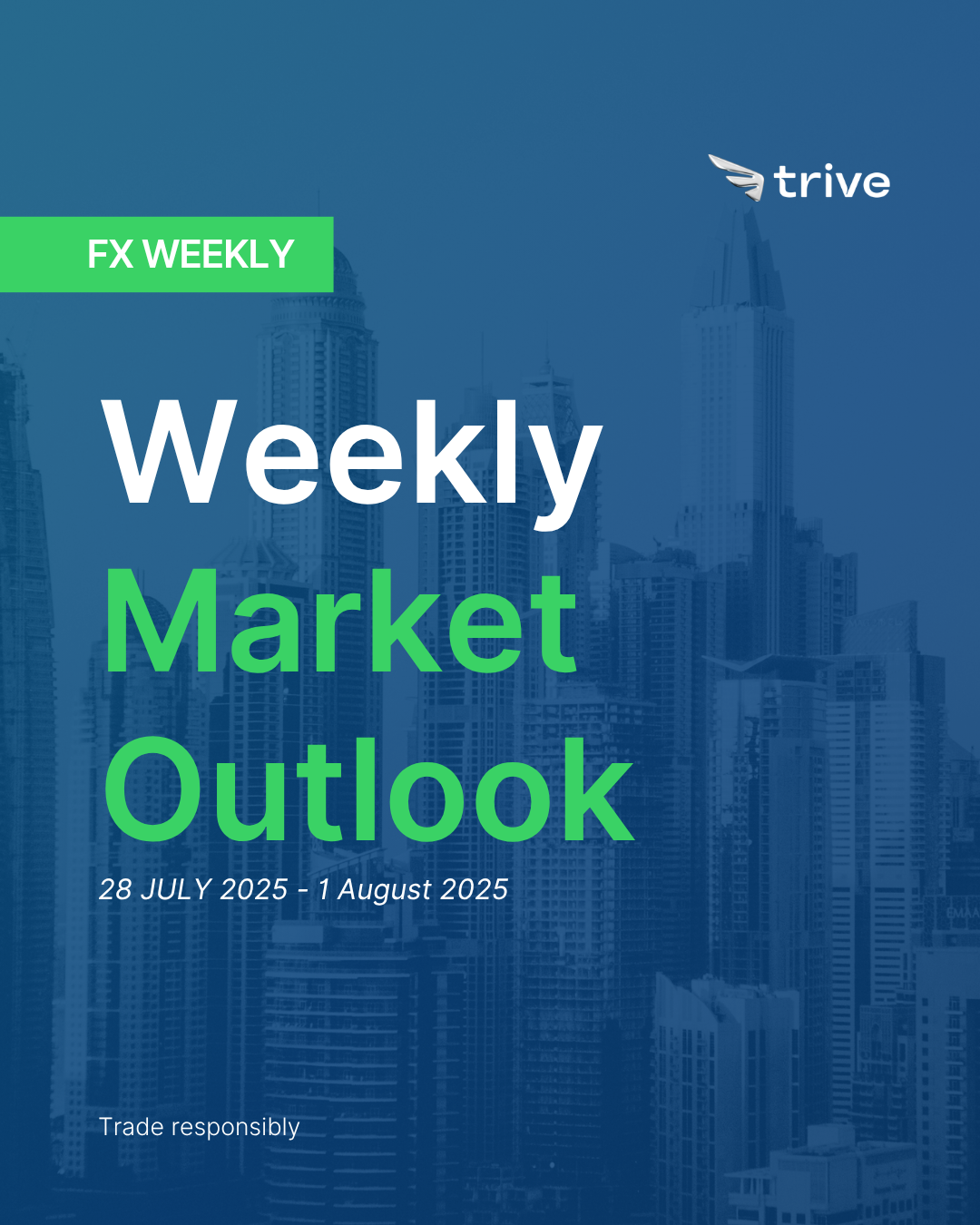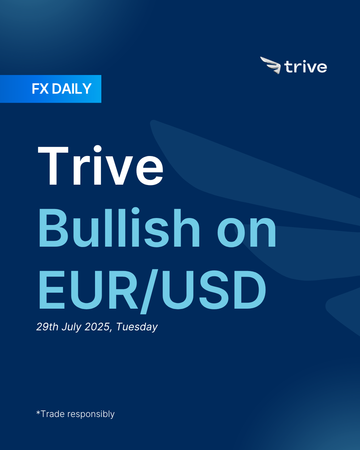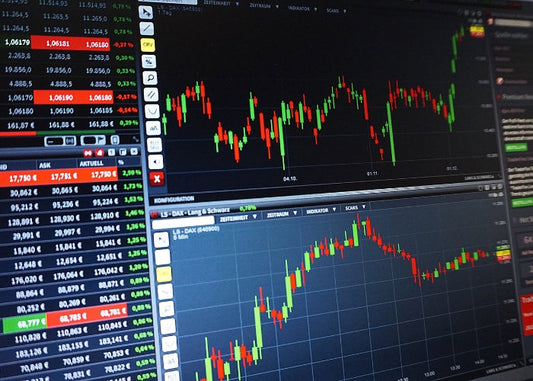FX Weekly: Trive’s Week Ahead Views

This week is incredibly busy with focus on the August 1st trade deal deadline, as well as US-China trade talks on Monday and Tuesday. We will also see rate decisions from the Fed, BoJ and BoC. Data wise, highlights include US NFP, ISM Mfg. PMI and PCE. Eurozone CPI and GDP will also be in focus, as will the Australian CPI and Retail Sales reports. Bond traders will be watching the US Quarterly Refunding announcement too.
Monday
The week opens with high-stakes US-China trade negotiations in Stockholm, where Chinese Vice Premier He Lifeng and US Treasury Secretary Bessent will attempt to extend the 90-day tariff truce due to expire August 12th. Without an agreement, tariffs would revert to 145% on US imports and 125% on Chinese exports. Both sides have shown recent signs of détente China suspended its DuPont probe and eased export bans, while the US resumed shipments of tech components. Bessent floated a rolling 90-day extension, which if confirmed, could offer markets a reprieve and risk assets a short-term boost.
Later Monday, the US Treasury will release its Quarterly Financing Estimates (20:00 BST / 15:00 EDT). The prior update penciled in $554bn in Q3 borrowing versus $514bn in Q2, targeting an $850bn cash balance by end-September. With long-end yields still elevated and politically unpalatable for the Trump administration Treasury Secretary Bessent is expected to lean further into bill issuance. Wells Fargo projects net T-bill issuance of $475bn in Q3 and forecasts bills will reach 22.5% of total marketable debt by end-2027, up from 21.9% in 2024.
On the data front, Germany’s GfK consumer climate index for August and the Dallas Fed’s July manufacturing activity index will provide early reads on confidence and industrial sentiment ahead of heavier midweek macro flows.
Tuesday
Markets turn to the US July Consumer Confidence report and June JOLTS job openings. Consumer expectations will be closely scrutinized for signs of inflation concerns or softening labor perceptions, while job openings remain a leading barometer of employment slack. Elevated openings have historically supported wage growth and delayed broader labor market normalization.
These datasets will serve as a prelude to Wednesday’s heavier labor and macro releases, and may set the tone for US session risk sentiment.
Wednesday
This is the most critical day of the week by far. The FOMC rate decision is widely expected to leave rates on hold at 4.25 4.50%, with every major economist surveyed by Reuters expecting a pause. However, dissent is in the air. Fed Governors Waller and Bowman have publicly called for a rate cut, citing labor softening, and Morgan Stanley expects both to vote for easing. That may generate headlines and fuel speculation for action in September.
The post-meeting press conference with Chair Powell will be pivotal. Markets will scrutinize his tone for clues about whether the Fed sees rising tariffs and political pressure as reasons to pivot dovishly or to maintain a cautious hold. Powell is also likely to face questions about his future, as Trump has hinted at nominating a new Fed Chair before Powell’s term ends in May 2026. Morgan Stanley sees Powell reiterating a “wait-and-see” approach, signaling that policy is “well positioned” for now.
US Q2 GDP Advance is also out, with consensus expecting a sharp rebound to +2.5% (vs. -0.5% prior), bolstered by service sector strength and improved manufacturing momentum. That said, the Atlanta Fed’s GDPNow sits at 2.4% and S&P PMI data warns of weakening demand under the surface. Any disappointment could reinforce the Fed doves’ case for preemptive easing.
US PCE (Advance) and Pending Home Sales round out the US calendar, along with the Quarterly Refunding Announcement. The latter will be closely watched for any changes in coupon or FRN auction sizing, although Wells Fargo expects no change until at least February 2027.
Globally, the Bank of Canada is also expected to hold rates at 2.75%. Inflation remains sticky and the labor market is stable, reducing urgency to act. However, trade tensions and consumer softness may nudge the BoC toward a more dovish tone. Money markets only price a 56% chance of one more cut this year, suggesting a high bar for dovish surprises.
In Europe, EZ Q2 GDP is forecast to stall after Q1’s tariff-driven +0.6% surge. Investec warns of a -0.3% Q/Q print due to front-loaded demand fading and external headwinds. However, policymakers are expected to discount this as a trade distortion rather than a trend shift.
Australian CPI for Q2 is also due, expected at +0.8% Q/Q headline and +0.7% trimmed mean. Despite a downside May monthly print, Westpac maintains a +0.9% forecast. With core inflation still above the RBA’s implied 2.6% target, rate cut bets are elevated markets currently price in 86% odds of an August cut and 57bps of total easing by year-end.
Thursday
Focus shifts to Asia and Africa. The Bank of Japan is expected to hold rates at 0.50%, with Bloomberg sources confirming no immediate post-election policy shift. However, the BoJ’s Outlook Report will be key, especially following the US-Japan trade deal that reduced tariff threats. Sources suggest a rate hike remains possible later this year, with October flagged as a potential date by JPMorgan. For now, the BoJ will likely stick to gradual JGB purchase reductions while assessing fiscal and trade-driven price risks.
The SARB in South Africa delivers its rate decision as well, with markets split 17 of 27 economists expect a 25bps cut. The key variable was the July 23rd inflation print, which rose to 3.0% Y/Y exactly at the SARB’s lower bound. With new US tariffs set to hit South African exports from August 1st, policymakers may opt to hold and reassess in Q4.
Chinese NBS PMIs for July also drop Thursday, providing a timely read on manufacturing and services momentum amid cautious policy signaling and ongoing trade discussions. Last month’s PMIs remained mixed (Manufacturing 49.7, Non-Manufacturing 50.5), and little improvement is expected given fading fiscal impulse and external fragilities.
Australian Retail Sales will close out the ABS series with a bang if Westpac’s +1.0% forecast materializes. The expected rebound reflects technical distortions and one-off boosts but won't shift the broader picture of consumer fatigue.
In Europe, German and French CPI flashes for July and German Unemployment for the same month are scheduled. Across the Atlantic, the US PCE (Final) is forecast to rise +0.3% M/M for both headline and core, consistent with CPI and PPI trends. Pantheon Macroeconomics expects a firming in core goods as tariff effects start to filter through.
Weekly US Initial Claims and Canada’s May GDP complete the lineup. Canadian GDP will help clarify whether BoC expectations for a soft landing are panning out.
Friday
The week culminates in a stacked US session. The US Jobs Report for July is expected to show payroll growth of 102k (vs. 147k prior) with unemployment ticking up to 4.2%. Wage growth is seen at +0.3% M/M, and workweek hours flat at 34.2. Barclays is well below consensus at 75k, citing a likely reversal in state/local hiring. Seasonality distortions make interpretation tricky, but a weak report could embolden Fed doves like Waller, who argue for preemptive cuts to stave off labor deterioration.
ISM Manufacturing PMI is also due, with consensus at 49.6. However, S&P’s flash PMI painted a gloomy picture falling to 49.5 with sharp declines in output and confidence. The ISM may be overshadowed by the jobs data and tariff developments, but any upside surprise could challenge the broader slowing narrative.
Finally, the Eurozone CPI flash for July is seen at 1.9% Y/Y headline, with supercore easing to 2.2%. June’s upside surprise faded, and Investec sees little reason for big moves this time around. The ECB’s July message was one of patience, with inflation undershoots to be looked through especially with US-EU trade deal talks ongoing. Markets have scaled back year-end ECB cut expectations to just 14bps.
All this comes against the backdrop of the August 1st US Tariff Deadline, where failure to secure “reciprocal” deals could trigger a wave of levies on EU goods. The US has struck new agreements with Japan, Indonesia, and the Philippines, but the EU remains in tense negotiations. If talks collapse, the EU has readied countermeasures on €93bn in US goods, effective August 7th.
Disclaimer
This material is provided for informational purposes only and does not constitute financial, investment, or other advice. The opinions expressed in this material are those of the author and do not necessarily reflect the views of Trive International. No opinion contained in this material constitutes a recommendation by Trive International or its author regarding any particular investment, transaction, or investment strategy. This material should not be relied upon in making any investment decision.
The information provided does not consider the individual investment objectives, financial situation, or needs of any specific investor. Investors should seek independent financial advice tailored to their individual circumstances before making any investment decisions. Trive International shall not be liable for any loss, damage, or injury arising directly or indirectly from the use of this information or from any action or decision taken as a result of using this material.
Trive International may or may not have a financial interest in the companies or securities mentioned. The value of investments may fluctuate, and investors may not get back the amount they originally invested. Past performance is not indicative of future results.
For more information about Trive International, please visit http://trive.com/int
Additional Information
Investing involves risk, including the potential loss of principal. Diversification and asset allocation strategies do not ensure a profit or guarantee against loss. The content in this material is subject to change without notice and may become outdated or inaccurate over time. Trive International does not undertake any obligation to update the information in this material.
By accessing this material, you acknowledge and agree to the terms of this disclaimer. If you do not agree with these terms, please refrain from using this information.
No comments
Home
Trive
TriveHub





0 comments